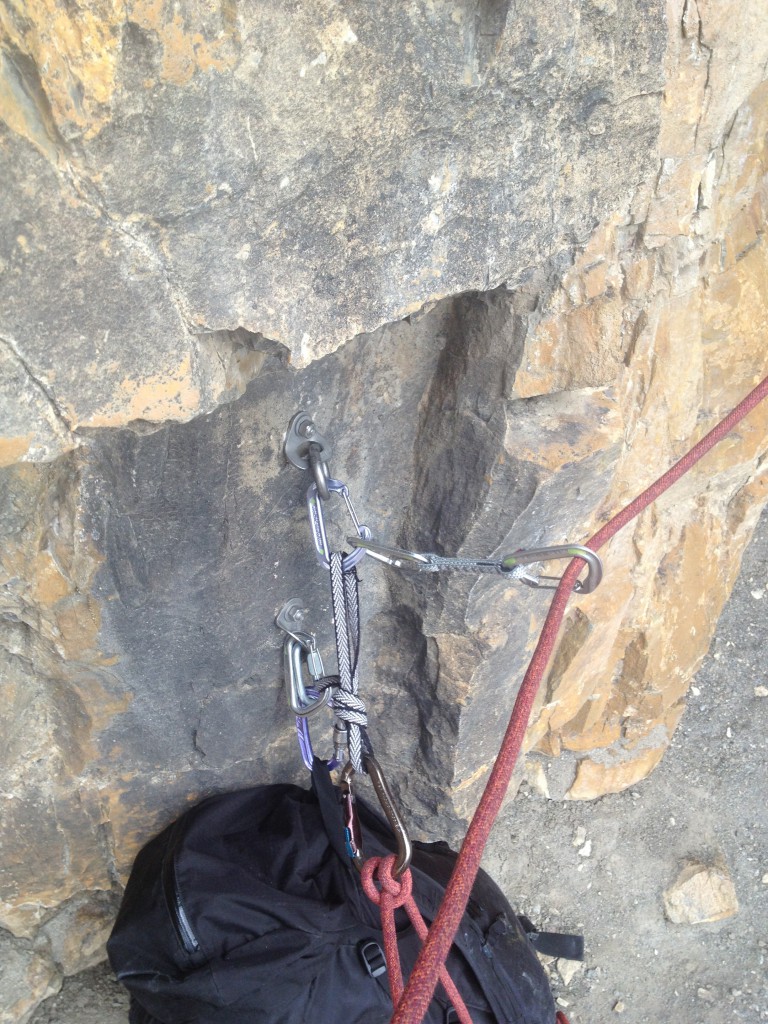Date: 3rd September 2013
Anchor Clipping, Direct Anchor Belays (edited Sept 4). Also some newer thought here thanks to Kirk Mauthner at Basecamp Innovations.
The bottom line is this: I’ve played with factor-two falls onto anchors a couple of times with the top piece clipped and not, as have some of my friends and colleagues. It’s just not a good thing–don’t fall off before your piece, and get a good piece ASAP off the belay!
Whenever I use a “safety” system I ask what that system is supposed to do, and how well it will do what I want it to do, and what the limitations are. A reserve parachute on a paraglider works, but not below a certain altitude. It’s still safer to fly with one than not, but you have to understand it’s limitations, and not just blindly assume it will add safety. A climbing rope generally adds safety to climbing; but tie five people onto a climbing rope with no anchors between them in steep terrain and it’s NOT safer; the illusion of safety is there because there is a rope, but in reality if one person falls everyone may die, not just one. I often see novice mountaineers on steep snow roped together; they have just added a lot of danger to the equation but feel “safer.” Their safety system will not do what they expect, and is in fact worse because they feel “safer” and won’t take the care the situation warrants. In the same way clipping the top piece in an anchor often falls into the same, “I’m being safer because I’ve done something” when in fact I think it’s often more dangerous than not clipping the top piece.
Many leaders in multi-pitch climbing like to clip their rope (s) into the top piece in an anchor until they have the first piece or bolt of the pitch clipped. I’ve written about this tactic before, but more and more I’m seeing it taught as an “always do this, it’s safer” system when in fact it often doesn’t add any safety, and may in fact add considerable danger for both the leader and the belayer. Clipping the top piece may in fact also sometimes be a really good idea, but to think it’s a good idea “all the time” is, to me, seriously flawed thinking.
The main idea behind clipping the leader’s rope through the anchor as a first “piece” is to protect the belay from a factor two fall. A factor two fall, as most climber already know, is when the leader falls off above the belay with no gear in and impacts the rope/belay with a very high force. Ropes dissipate energy forces over time; with a factor-two fall the total fall is twice the distance the climber/rope is above the belay, with only half that amount of rope in the system to absorb the fall. Vicious. I’ve caught two “real world” factor two falls over the years, it’s a memorable event–big forces, very violent, fast. It’s definitely a “don’t do this” sorta situation, and on the surface it seems to make sense to clip the top piece in an anchor to reduce the impact force. But it’s often like using a rope with no gear in–nice idea, but does it add safety for anyone?
The theory is that by clipping the top piece there will be more rope in the system, and the leader won’t take a true factor two fall. The “extra” rope between the belay device and the first piece will lower the force. But if you look at the numbers this amount of rope will do very little; if the climber is 2M above the belay and falls the total fall will be 4M (factor two, 4M fall divided by 2M of rope=2). If the top piece is 30cm above the belayer’s device and the belayer was tied in place perfectly the total rope in the system would be 2.3M, and the fall still 4M, and the fall factor is still a very, very high 1.74. But most belayers aren’t tied perfectly in place, and will in fact accelerate violently toward the wall( and again, you have to actually try this with real-life violent falls, the forces are crazy high), the belayer’s hand and then the belay device will hit the ‘biner the rope goes through, and now you’re back to a factor two or very close to it in any case. If the belayer manages to hold onto the rope (if…). Some energy will be dissipated by slamming the belayer into the wall. Not much is really done to reduce the fall factor even in a “perfect” scenario. This will get very technical very fast but with a fall factor of 2 or 1.74 the actual impact force is likely to be about the same anyhow (rope construction limits peak loads for this very reason, our bodies break when subject to above about 8kN of force, and a belay device slips at somewhere between 3-4kN, so the peak force isn’t going to be what’s intuitively expected..).
But here are some things I’m thinking about:
-When the leader falls with the top piece clipped the belayer is likely to be accelerated extremely violently toward the wall, especially in lower-angled terrain where the belayer stands horizontally away from the anchor. Most people who are about to face-plant at a high rate of speed put their hands up. Most belay plates (ATC, etc), don’t work well with both hands at shoulder height. Catching a fall with the first piece clipped is like getting power-slammed into the wall at a very high rate of speed, it’s just nasty.
-After getting slammed into the wall very violently the belayer is then likely sucked up hard against the top biner anyhow, which gets rid of the lower impact fore concept almost entirely. In fact, with the added friction (never mind lacerated hands etc) the force may be more violent…
-Clipping the top piece in an anchor puts twice the load onto that piece as it would otherwise see (leaders’s fall force plus the force required to stop it). That may be too much for some gear.
-The rope the belayer used to clip into the anchor may be more useful for lowering the fall factor than clipping the leader’s rope through the anchor. This is a bit tricky to visualize, but as discussed above the belayer gets sucked into the anchor when it’s clipped with the leader’s rope and still locks off the belay device then the overall fall factor hasn’t been reduced much. But if the belayer clips into the anchor with 30cm of rope and that rope is still in the system (as it will be) then it may do a little more good than the rope running through the top piece. Or it may not, it’s going to be a violent fall either way.
-I recently belayed a leader who clipped his rope through the top piece on an anchor that was at my waist level, and horizontally about three feet away (the picture is close enough to this situation). A large flake jutted out of the wall between me and the anchor; if the leader fell I was going to get seriously injured on that flake… I see similar situations a lot now, and most of the time I don’t think clipping the top piece in an anchor improves safety for either the belayer or leader.
There are situations where it makes sense to clip the top piece, but in most cases I think it makes more sense to really visualize what’s going to happen if the leader falls and plan accordingly. In most cases I don’t think it makes sense to clip the top piece. I urge anyone who thinks it always does make sense to clip the top piece to start doing some real-world testing; that testing tends to be short-lived, it just sucks to get yanked violently into the wall. So does catching the violent fall on your waist loop, but generally less so if the belayer organizes the system for the fall.
What does make sense is to think about what’s going to happen in a vicious fall and get organized for that. Be snugly clipped in (with the rope, not some PAS or sling that’s not dynamic) to the anchor, and have a visualization for where you’re likely to go, and get as far into that position as is reasonable. So if your leader is going to fall past your ledge then get below below the anchor, with the tie-in rope snug to the focal point. Once the leader has something solid clipped the fall dynamics change again; get organized for your new trajectory, and make sure it’s safe. Years ago I hit my head with speed on a roof just over the belay stance when the leader fell and yanked me into the air. I hadn’t been thinking of what was going to happen when he fell. A “directional” belay piece for un upward pull is important when using gear anchors, but most bolted belay stations don’t offer that option.
-Wear gloves when belaying with an ATC or anything but a Gri Gri (probably with a Gri-Gri too, but I haven’t had problems other than dirty hands belaying without gloves). If the rope does run a bit you won’t burn your hands. That said, I haven’t burned my hands with a modern ATC when catching hard falls, but gloves are likely just a good idea.
Thinking about what’s going to happen in a nasty fall takes just that, thought. But I think clipping the top piece and saying, “All good!” is roughly the same as wearing a rope without any gear in between the climbers. Might be OK on a ridge or really block terrain, but most of the time it’s not a good idea…
Organize the rope’s potential path so that if the leader does fall it will run cleanly and not lacerate or break your legs, as has also happened in hard falls onto the belay. To me it’s important to realize those first few moves until the leader gets gear in are always serious, and should be respected.
Another solution to this problem is the Direct Anchor Belay, and it solves a lot of the problems. The voice over on this video is rather dry, but the ideas are good. With bolts or good ice screws this is what I’m likely to do most of the time now.
Cut and paste this if the video above doesn’t work: https://vimeo.com/44869774
The limitations are that it’s difficult to pay rope out very fast. I don’t think an ATC makes sense at all; if the first piece pops but the belayer has already unclipped the friction redirect things are going to be messy. Munters kink the rope up, but seem like the best choice.
There are very few “absolutes” in climbing systems. Clipping the top piece may be a good idea, but it’s not always a good idea.
For more reading:
A little dated and aimed primarily at guides but still very useful: http://www.outdoorlink.org/research-papers/part-5-belaying-lowres.pdf
http://wallrat.com/PDF_Files/forcesinleadfalls.pdf
And in German but good illustrations: http://www.alpenverein.de/chameleon/public/04c4aa2d-3f2c-9ba8-b233-a081dc9965ab/Tuber-am-Stand_19803.pdf
Posted in: Blog
Will be sharing this posting link with a few climbing clubs! Thank you, Will. Can’t say I’ve been power-winched towards the wall (thank God), but I’ve had one non-injury mid-air crash with my climber while belaying (’till I learned about correct tying down procedures to equalize weight disparity … I’m sure you have some tremendous insight on that practice as well!).
Are we to take this to mean that you no longer recommend having the belayer “protect” the anchor?
Whether to belay from the anchor or the harness is should be done depending on the situation. Both methods have their respective pro’s and contra’s. Either method has its serious (dis)advantages, depending on the situation. Be careful to dismiss one method because the other FEELS more safe or more logical to you. In stead it is better to perform actual tests to determine whether once assumption is true or not. These tests have been done. For instance: http://vimeo.com/44869774. An other interesting article on such tests can be read in BergundSteigen.at issue 3/2012, page 36-41. For those who are not familiar with this publication – on risk management in (ski)mountaineering – here’s the deal: ‘Berg und Steigen’ is co-production of the the German, Austrian, Swiss and Italian [from the German-speaking parts of Italy] alpine clubs. These alpine clubs have over 1.6 million members. There’s a lot of professionalism going on here. The magazine is published 4 times/year (€ 20,-/year). All issues/articles can be read on-line. You have to be able to read German though…
Want to read more on what are considered the best options for making a [safe] belay and/or how to belay safely I suggest these publications as well:
– http://www.alpenverein.de/chameleon/public/07ace84a-bc33-615a-62a3-151e7b8b859a/Standplatzbau-Juli-2012_19947.pdf
– http://www.alpenverein.de/chameleon/public/04c4aa2d-3f2c-9ba8-b233-a081dc9965ab/Tuber-am-Stand_19803.pdf
If you don’t clip the lead rope through the anchor and are just belaying from your belay loop with an ATC (which I think is what you’re recommending) and the climber falls….ending up beneath you, isn’t the breaking hand now in the wrong position (down)? With the fall being caught below you…isn’t the break hand position going to be upwards above the ATC (awkward)?
How does this effect the belays ability to hold a (factor 2!) fall?
This is the main reason I have been clipping the rope through the anchor above me.
Hi Will. Great post. I love the posts that generate snarky feedback. I thought the telemarkers were the worst, but it seems the belay police are out in force. I love how the comment above directs you to the same link you included in your original post, although it seems you were good enough to share his link. The patronizing/superior/didactic tone is so German/Swiss/Austrian….”We have it all figured out, our way(s) are the best, nobody else knows what they’re doing.” I don’t know if he lives in one of these countries, but he should! I live in Switzerland, and I love it here, but, man, big sigh, sometimes it just drives me crazy. In any case, I am confident of your professionalism (!) and I always appreciate your cut-through-the-bullshit fresh perspective.
About belaying a leader directly from the anchor…what belay device or knot do you think works the best (or the least worst) for this kind of situation? The humble Munter? One of the links seems to show a tube-style device with the brake strand redirected…does that actually work?
Also, you mentioned some cases where you might prefer to actually clip the lead rope into a piece on the anchor. In what situations would you make that decision?
OK, thanks again, and all the best.
I agree with you that it’s incredibly important to have a plan in place regarding what you will do if the climber falls before the first piece – where the rope will run, what you’ll be pulled into, etc. However, I am not certain that not clipping the anchor is the best solution. Here’s why: an ATC style device wouldn’t work if the belayer went into the automatic “down” position that we are all so accustomed to using. After the climber falls past the anchor and belayer, the position that the rope is in becomes an upside-down “U” — requiring the belayer to arrest the fall by pulling UP on the rope, not down.
While I agree that getting pulled into the anchor at high speed would suck, instinctively braking down and losing control of your rope and dropping your partner 60 or 70 meters to the end of the rope would probably suck more. So, if you choose to forego clipping the anchor and the climber falls before placing a piece, be fully extended on your tie-in from the anchor and be prepared to brake UP. Or, use a Grigri or Cinch type device, but those do not work for double rope systems, plus they are heavier and they cannot be used to rappel, so you have to bring two devices.
Better than clipping into just one piece it seems to me is be clipping the powerpoint — then the force is distributed between the two or three pieces in the anchor. However, that does nothing to prevent the belayer from accelerating toward the anchor – the only thing that can prevent would be placing a piece below the belayer to “anchor” him or her to the ledge or whatever the belay is.
Since I usually use a Reverso or Reversino on multipitch and don’t trust myself to have the wits to pull up on a factor 2 leader fall, I think from now on, I will still have the leader clipped through the power point of the anchor at first, but if there’s any chance at all of a fall before the first piece, if possible I’ll probably throw a nut or something below me and clip it to a sling girth hitched through my harness — so that any extension would be short enough to prevent me from being pulled into the anchor.
Thanks for the post, Will. Definitely great food for thought that generated some good discussion here in my kitchen! Ultimately, I think we agree that the most important thing is to think it through and be prepared.
Great post Will, really insightful. I’ve often clipped a draw at the anchor for exactly the reasons that everyone teaches it.
What’s interesting about your post is that you’ve pointed out the real issue here. I had to read your post 3 times before what you are really trying to say clicked:
It’s not so much that the belayer will get yanked into the wall (that often happens when lead belaying in any situation), it’s the fact that in a 20-30′ factor 2 fall, the belayer isn’t just going to get pulled into the wall, they are being pulled into the wall with somewhere between 1000lb-2000lb of force… which is kinda like tying yourself to a Ford Pinto and throwing it off a bridge… except those forces are pulling you into a wall 12 inches away.
Great insight, definitely going to keep this at front of mind.
[…] It’s been interesting reading people’s thoughts on whether or not to clip the top piece …. Their thinking has helped me clarify my own. I do think it makes sense to clip the anchor in some cases. But in most cases I don’t think it does make sense, as clipping the anchor does not do what most people who want to clip it seem to think it does. If a safety system does not improve safety then I question why I am using it. […]
Yeah agree mostly. Mostly, yes, gotta think about it, just following ‘rules’ tends to make people not very safe in the long run. However, you seem to think that people can catch a Factor 2 fall on an ATC, with the force going up or down – I think the chance of catching such a fall is low – say 20%. Petzl did a cute demo when the Gri Gri came out – experienced, burly, alert climbers with gloves on could not catch a FF 1 fall. Personally, as a belayer, I would rather have the force on me go UP rather than DOWN, even with being slammed into the wall.
But clearly, the most important take away is: don’t fall off before you get a piece or two in – those first pieces are VERY important.
Ratagonia
I have to disagree with this system. I would not trust a single piece of trad gear, or especially an ice screw to take the initial force of a high factor fall. If it blows, I don’t see how the next piece wouldn’t be just as shock loaded and also fail. This seems to fly i the face of why we equalize anchors, and also orient them in the direction of pull (or a combo of both). Belaying off the harness tight against the anchor (tied in with the rope) oriented in the direction of fall (without the anchor clupped) just seems like it would reduce some of the load. Belaying off the anchor like this totally removes any possibility of a dynamic belay. Not to mention paying out slack would be incredibly jerky and annoying for the leader. Using an ATC type device looks like an accident waiting to happen. If I was that concerned about the leader factor two falling on the anchor, I’d lower down several feet on the belay to provide more rope. Finally, if the leader did clip the anchor on a bomber piece, you could put in an upwards directional as well.
So in a nutshell.
Don’t be an idiot.
There are no hard and fast rules in climbing, ever. There is never the always always always do this. There are exceptions. Usually a lot of them.
Know your gear, know the mechanics, and don’t be an idiot.
Will,
I found this article interesting. I am especially taken back by your example, “[a] climbing rope generally adds safety to climbing; but tie five people onto a climbing rope with no anchors between them in steep terrain and it’s NOT safer…” as this exact situation lead to the serious injury of a group of climbers and the subsequent death of a climbing ranger attempting to rescue them.
The incident occurred on Mount Rainier, June, 21 2012.
More then anything else the take away should be: if you don’t know your shit hire a professional guide who does… otherwise stay home and try not to get anyone killed.
http://www.nps.gov/mora/parknews/hall-memorial.htm
http://www.nps.gov/mora/parknews/upload/Hall-SAIT-Factual-Redacted-Copy-2.pdf
Good read– another lesson to be learned from this is to always build a ground anchor and to set the belayer up for the expected direction of pull (towards the first piece of pro) before the leader takes off– the less moving the belayer does, the more likely they are to continue to hold that break strand.
“-Clipping the top piece in an anchor puts twice the load onto that piece as it would otherwise see (leaders’s fall force plus the force required to stop it). That may be too much for some gear.”
^^
Pieces of pro feel twice the load because of the pulley effect– the weight of the climber and the belayer. Every piece of pro has to be able to potentially hold this because that is what will happen if you fall regardless of where you are on the route…so that sentence isn’t quite accurate, I don’t think, or I am misunderstanding it.
#Kelly
I think the difference is the fall factor. If you clip in to the anchor you get FF 2, or close to, if you clip in 2 meters above you get FF 1, if you fall at the same place, in this case 4 meters above the belay.
Hey Will,
Ever thought of climbing past the anchor, clipping the first piece on the next pitch, and coming back down to the anchor? The second is then brought up on the strand coming down from the high piece, then whoever leads the next pitch can’t factor 2, or anywhere close. There are obviously limitations to this, and it uses up more time and rope, but it works in most normal situations, the Europeans seem to like it.
another solution is to extend the length of rope anchoring belayer. There are many ways to do this. Increasing the length of rope between the belayer and climber could reduce the fall factor significantly, as well as eliminating the potential to get slammed into the anchor.
The link http://www.outdoorlink.org/research-papers/part-5-belaying-lowres.pdf no longer works
I'm more than happy to hear your thoughts on what I've written. Please note that all comments will be moderated before publishing. Thank you for joining the conversation.



